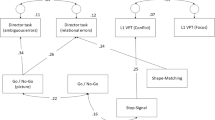Abstract
We examined the relations between joint action and Theory of Mind (ToM) in neurological patients with impairments in ToM, in control patients (who passed ToM tasks) and non-lesioned controls. In two experiments, joint action was assessed in a “social Simon” procedure where spatial compatibility effects were tested under two-alternative forced-choice and under go/nogo conditions, which participants performed in isolation or alongside another participant (the joint action condition). In Experiment 1, patients with impaired ToM showed evidence of increased spatial compatibility effects under standard (two-alternative forced-choice) conditions but, unlike the control participants, these effects disappeared in the joint action condition. In Experiment 2, the ToM patients were asked to pay particular attention to their co-actor. With these instructions, ToM patients with lesions of posterior parietal cortex now showed a sustained spatial compatibility effect in the joint action condition, while ToM patients with lesions primarily involving frontal regions showed an initial effect of spatial compatibility that decreased across trials. The data suggest common processes involved in ToM processing and joint action effects, related to either the ability to attend to appropriate social cues (affected in posterior parietal patients) or the ability to recruit sufficient resources to code another’s actions (affected in frontal patients).







Similar content being viewed by others
Notes
Note that some of the patients had a hemiplegia which made it impossible for them to make two handed responses.
There was a trend for the control patients to show a larger congruency effect than the non-lesioned controls (see Fig. 2). However, there was a larger congruency effect for the ToM patients even when compared with the patient control group alone (t(16) = 2.44, P < 0.05.
References
Apperly I, Samson D, Chiavarino C, Humphreys GW (2004) Temporo-parietal lobe contribution to theory of mind: neuropsychological evidence from a false belief task with reduced language and executive demands. J Cogn Neurosci 16:1773–1784
Apperly IA, Samson D, Humphreys GW (2005) Domain-specificity and theory of mind: evaluating evidence from neuropsychology. Trends Cogn Sci 9:572–577
Bird CM, Castelli F, Malik O, Frith U, Husain M (2004) The impact of extensive medial frontal lobe damage on ‘Theory of Mind’ and cognition. Brain 127:914–928
Burgess PW, Shallice T (1997) The Hayling and Brixton tests. Thames Valley Test Company, Bury St Edmunds
Call J, Tomasello M (1999) A nonverbal false belief task: the performance of children and great apes. Child Dev 70:381–395
Frischen A, Loach D, Tipper SP (2009) Seeing the world through another person’s eyes: simulating selective attention via action observation. Cognition 111:212–218
Frith U, Frith CD (2003) Development and neurophysiology of mentalizing. Philos Trans R Soc B-Biol Sci 358:459–473
Guagnano D, Rusconi E, Umilta CA (2010) Sharing a task or sharing space? On the effect of the confederate in action coding in a detection task. Cognition 114:348–355
He X, Lever A, Humphreys GW Interpersonal memory-based guidance of attention is reduced for ingroup members. Exp Brain Res (sub.)
He X, Sebanz N, Humphreys GW Memory-based guidance of visual attention based on shared task components. J Exp Psychol Learn Mem Cogn (sub.)
Lough S, Gregory C, Hodges JR (2001) Dissociation of social cognition and executive function in frontal variant frontotemporal dementia. Neurocase 7:123–130
Lough S, Kipps CM, Treise C, Watson P, Blair JR, Hodges JR (2005) Social reasoning, emotion and empathy in frontotemporal dementia. Neuropsychologia 44:950–958
Nelson HE, Willison J (1991) National adult reading test, 2nd edn. NFER-Nelson, Windsor
Premack D, Woodruff G (1978) Does the chimpanzee have a theory of mind? Behav Brain Sci 4:515–526
Rowe AD, Bullock PR, Polkey CE, Morris RG (2001) “Theory of mind” impairments and their relationship to executive functioning following frontal lobe excisions. Brain 124:600–616
Samson D, Apperly I, Chiavarino C, Humphreys GW (2004) The left temporo-parietal junction is necessary for representing someone else’s beliefs. Nat Neurosci 7:499–500
Samson D, Apperly IA, Kathirgamanathan U, Humphreys GW (2005) Seeing it my way: a case of a selective deficit in inhibiting self-perspective. Brain 128:1102–1111
Samson D, Apperly IA, Humphreys GW (2007) Error analyses reveal contrasting deficits in “theory of mind”: neuropsychological evidence from a 3-option false belief task. Neuropsychologia 45:2561–2569
Saxe R, Carey S, Kanwisher N (2004) Understanding other minds: linking developmental psychology and functional neuroimaging. Annu Rev Psychol 55:87–124
Sebanz N, Knoblich G, Prinz W (2003) Representing others’ actions: just like one’s own? Cognition 88:B11–B21
Sebanz N, Knoblich G, Prinz W (2005a) How two share a task: corepresenting stimulus response mappings. J Exp Psychol Hum Percept Perform 31:1234–1246
Sebanz N, Knoblich G, Stumpf L, Prinz W (2005b) Far from action-blind: representation of others’ actions in individuals with autism. Cognitive Neuropsychol 22:433–454
Simon JR (1969) Reactions towards the source of stimulation. J Exp Psychol 81:174–176
Stone VE, Baron-Cohen S, Knight RT (1998) Frontal lobe contributions to theory of mind. J Cogn Neurosci 10:640–656
Tsai C-C, Brass M (2007) Does the human motor system simulate Pinocchio’s action? Coacting with a human hand versus a wooden hand in a dyadic interaction. Psychol Sci 18:1058–1062
Welsh TN, Elliott D, Anson JG, Dhillon V, Weeks DJ, Lyons JL, Chua R (2005) Does Joe influence Fred’s action? Inhibition of return across different nervous systems. Neurosci Lett 385:99–104
Welsh TN, Lyons J, Weeks DJ, Anson JG, Chua R, Mendoza J, Elliott D (2007) Within- and between-nervous-system inhibition of return: observation is as good as performance. Psychon Bull Rev 14:950–956
Acknowledgments
This work was supported by a grant from the ESRC and the Stroke Association, UK.
Author information
Authors and Affiliations
Corresponding author
Rights and permissions
About this article
Cite this article
Humphreys, G.W., Bedford, J. The relations between joint action and theory of mind: a neuropsychological analysis. Exp Brain Res 211, 357–369 (2011). https://doi.org/10.1007/s00221-011-2643-x
Received:
Accepted:
Published:
Issue Date:
DOI: https://doi.org/10.1007/s00221-011-2643-x




